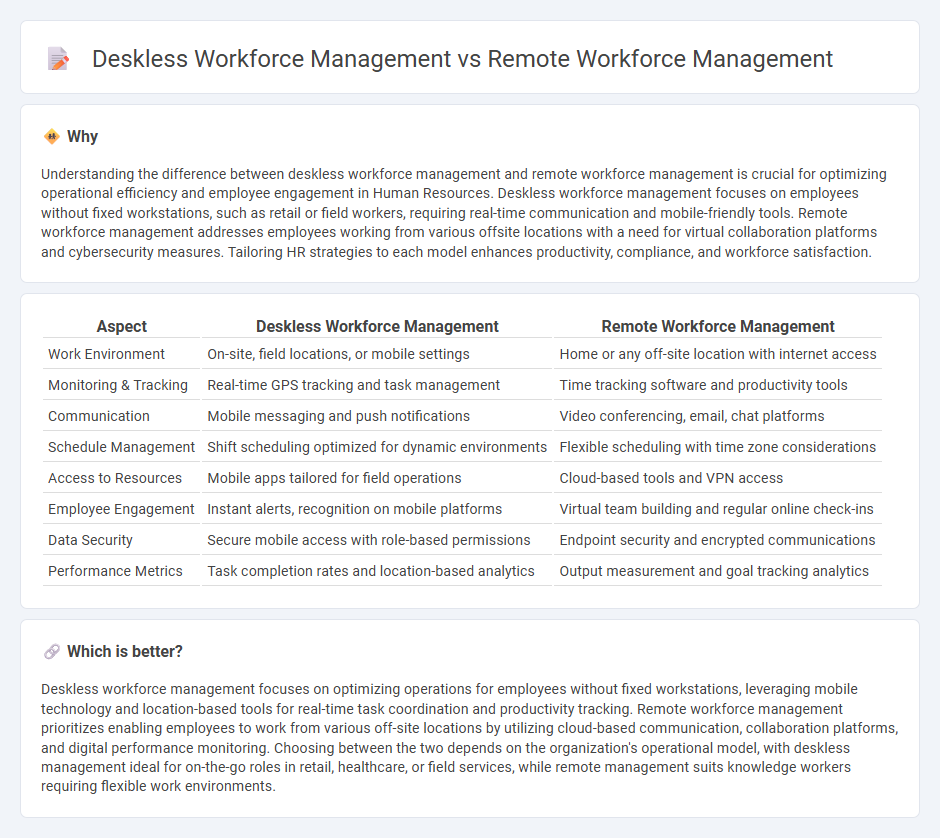
Deskless workforce management focuses on overseeing employees who operate outside traditional office settings, such as retail staff, healthcare workers, and field technicians, emphasizing real-time communication, task allocation, and mobile access to resources. Remote workforce management handles employees working from various locations, ensuring productivity through digital collaboration tools, performance tracking, and flexible scheduling. Explore the key strategies and technologies that differentiate and optimize deskless and remote workforce management.
Why it is important
Understanding the difference between deskless workforce management and remote workforce management is crucial for optimizing operational efficiency and employee engagement in Human Resources. Deskless workforce management focuses on employees without fixed workstations, such as retail or field workers, requiring real-time communication and mobile-friendly tools. Remote workforce management addresses employees working from various offsite locations with a need for virtual collaboration platforms and cybersecurity measures. Tailoring HR strategies to each model enhances productivity, compliance, and workforce satisfaction.
Comparison Table
| Aspect | Deskless Workforce Management | Remote Workforce Management |
|---|---|---|
| Work Environment | On-site, field locations, or mobile settings | Home or any off-site location with internet access |
| Monitoring & Tracking | Real-time GPS tracking and task management | Time tracking software and productivity tools |
| Communication | Mobile messaging and push notifications | Video conferencing, email, chat platforms |
| Schedule Management | Shift scheduling optimized for dynamic environments | Flexible scheduling with time zone considerations |
| Access to Resources | Mobile apps tailored for field operations | Cloud-based tools and VPN access |
| Employee Engagement | Instant alerts, recognition on mobile platforms | Virtual team building and regular online check-ins |
| Data Security | Secure mobile access with role-based permissions | Endpoint security and encrypted communications |
| Performance Metrics | Task completion rates and location-based analytics | Output measurement and goal tracking analytics |
Which is better?
Deskless workforce management focuses on optimizing operations for employees without fixed workstations, leveraging mobile technology and location-based tools for real-time task coordination and productivity tracking. Remote workforce management prioritizes enabling employees to work from various off-site locations by utilizing cloud-based communication, collaboration platforms, and digital performance monitoring. Choosing between the two depends on the organization's operational model, with deskless management ideal for on-the-go roles in retail, healthcare, or field services, while remote management suits knowledge workers requiring flexible work environments.
Connection
Deskless workforce management and remote workforce management intersect through the shared emphasis on coordinating employees outside traditional office settings, leveraging mobile technology, cloud-based platforms, and real-time communication tools to enhance productivity and engagement. Both approaches require adaptive scheduling, task management, and performance tracking systems tailored to dynamic work environments where physical oversight is limited. Integrating these management strategies enables organizations to optimize operational efficiency, employee satisfaction, and compliance across dispersed teams.
Key Terms
**Remote workforce management:**
Remote workforce management involves overseeing employees who work from various locations outside a traditional office, leveraging tools like cloud-based collaboration platforms, time-tracking software, and secure VPNs to maintain productivity and communication. It requires robust strategies for virtual team building, performance monitoring, and efficient task allocation to ensure operational consistency across different time zones and environments. Explore advanced techniques and technologies to enhance your remote workforce management capabilities.
Virtual collaboration
Remote workforce management leverages digital tools to coordinate employees who work from various locations, emphasizing virtual collaboration platforms like Zoom, Microsoft Teams, and Slack. Deskless workforce management, however, prioritizes real-time mobile solutions tailored for frontline workers, such as mobile workforce management apps and wearable technology, enabling instant communication and task updates. Explore more to understand how these approaches optimize virtual collaboration across different workforce types.
Time zone coordination
Remote workforce management centers on synchronizing teams across multiple time zones by leveraging digital tools like time tracking and scheduling software to maintain productivity and clear communication. Deskless workforce management prioritizes real-time coordination and flexible shift planning to accommodate employees in varied locations such as retail or field services, where traditional office hours may not apply. Explore effective strategies and tools to master time zone coordination for both workforce models.
Source and External Links
Hybrid & Remote Workforce Management Software - ActivTrak - Remote workforce management is the process of managing remote and hybrid employees using communication, software, and flexible processes that allow productivity across different time zones while balancing oversight; benefits include increased productivity, reduced burnout, improved engagement, and better hiring decisions.
Remote Workforce Management: Tips & Challenges | Sprinklr - Remote workforce management relies heavily on digital tools and flexible schedules, requires building team cohesion across physical distance, and involves different security and performance tracking measures compared to in-person or hybrid management.
Remote Workforce Management: The Guide to Success | Dialpad - Successful remote workforce management balances communication, processes, and technology to enable teams to work flexibly from anywhere, accommodating digital nomads and emphasizing stable internet access as key.
 dowidth.com
dowidth.com